Travel Through Guyana on a Harley-Davidson
By Peter & Kay Forwood
Guyana on a Harley (10/4/02 - 20/4/02)
Distance 1211 km (286350 km to 287561 km)
This is part of the eighth section of our around the
world trip.
Complete Trip Overview & Map
Coming from Venezuela via Brazil
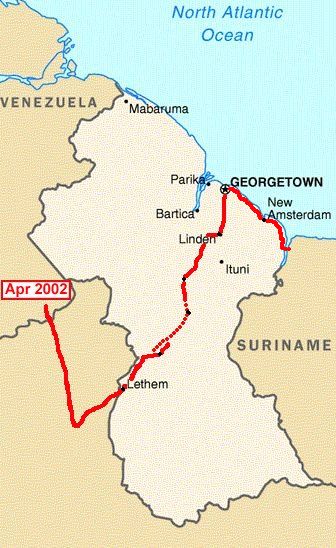 10/4/02 Brazil's paperwork also easy. Yellow fever vaccination
proof essential, we have obtained our Brazilian visas in Costa Rica, and
they were happy to use the Carnet and some of their own paperwork for the
motorcycle, no costs involved. Road good and ranching scenery with drying
dams and water birds kept us entertained on the almost traffic free road.
Boa Vista for the night. A planned sprawling town of little appeal.
10/4/02 Brazil's paperwork also easy. Yellow fever vaccination
proof essential, we have obtained our Brazilian visas in Costa Rica, and
they were happy to use the Carnet and some of their own paperwork for the
motorcycle, no costs involved. Road good and ranching scenery with drying
dams and water birds kept us entertained on the almost traffic free road.
Boa Vista for the night. A planned sprawling town of little appeal.
11/4/02 There seems to be an effort on the countries of
the region to improve the roads across borders to link more easily. Brazil
has built a new sealed road to Bonfim and is building a bridge across the
border river. We were stamped out of Brazil and caught the pontoon to Guyana
($US 2.20). The spread out town of Lethem had us lost looking for immigration,
police and then customs, but formalities easy and no payments required. Despite
Guyana working on the road to Georgetown the recent rains have made it impassable
to anything but the high 4x4 bedford trucks used in the region. The large
holes in the road are now full of watery mud to over a metre deep and the
forest makes it impossible to go around them (so we are told). Not wanting
to truck the motorcycle the 550 km to Georgetown we decided to ride to Annai,
125 km, then load the motorcycle onto a truck for the most difficult section
to just over the Essequibo River near Kurupukari, about 120 km, then ride
the remaining 305 km to Georgetown. This has to be arranged in Lethem as
goods are trucked from Brazil to Georgetown and they leave Lethem fully loaded.
Also we will have to pay the full fare as if travelling on the truck all
the way, $US 75.00 total price. No trucks leave for maybe three days so it's
tonight in Lethem. Thunderstorms rolled in again over the surrounding mountains
and as we walked the dirt road to dinner a lightening bolt hit Kay and myself
and a local man passing on his motorcycle. The ground was dry and we were
in rubber soled boots is all I can explain why we weren't injured. I felt
a spark on the top of my head while Kay had a shock down her spine and out
her big toe. Both our hearts were racing as we tried to calmly eat dinner.
12/4/02 Electricity used to be in Lethem from a diesel
generator, expensive and for just 6 hours a day, until the Chinese Government
built a small hydro plant just 20 km from town. We walked the almost 1000
steps to the top of the pipeline and for another 2 km's to the small header
dam. The trail goes deep into the rain forest with spectacular views down
onto the plains and across the mountains. The latest is there is a truck leaving
tomorrow evening, and we have arranged a lift from Annai, but things change.
Another night in Lethem, extremely friendly and helpful people.
13/4/02 It is great being able to speak in English again
as this was a British colony, although the dialect is a bit difficult to understand.
Also quite incongruously they drive on the left side of the road, the only
country in South America to do so, (We later found out that Suriname also
drives on the left side) a bit odd really as the entire population is only
about 700,000 people. Headed out of town to Annai, 125 km, reasonable dirt
although washboardy, great scenery across the plains with many wooden bridges.
We called in at Rock View Lodge to await the truck but by 9 pm the tent was
up and we were asleep having given up the wait. At 2 am we heard a truck
in the direction of the front gate but not in time to catch it. Perhaps it
was ours and we missed each other, perhaps not. How long do we wait here?
14/4/02 Unfortunately the owner of Rock View Lodge had
told us that he would definitely wake us when the truck arrived but despite
it blowing its horn he did not get up. We are now stuck here with no prearranged
lift and have to hope that a passing truck will have room for the bike and
us. We sat roadside all day waiting but by nightfall not one truck had passed
going to Georgetown. Most pass here at night timing it to catch the ferry
at Kurupakari in the morning, about 7 hours away, which only operates 6 am
to 6 pm. We set up a watch for the evening, one sleeping, one watching, about
90 minute shifts. There was no moon and the skies were clouded over with
drizzly rain intermittent all night. Our only light from a torch and the
many fireflies so bright we often thought they might be headlights of a distant
truck. Frogs and crickets kept the night noisy while owls would fly past
hooting and howler monkeys would call to each other from a nearby forest.
Occasionally a dog would pass rustling the foliage and startle us. With hours
to ponder you wonder why some days go wrong. Missing the truck by only 100
metres, the camera back opened spoiling a part used roll of film, the gas
stove clogged up and here we sit in drizzling rain.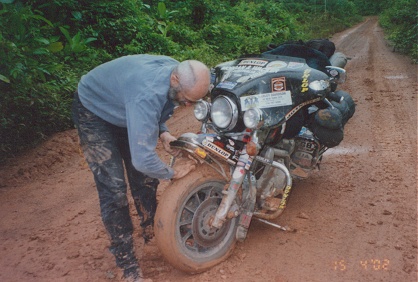
15/4/02 Frustrated by dawn and not prepared to sit through
another day's waiting we decided to press on to see how bad the road was.
After 10 km we were into full rain forest, the road became wetter but we were
hopeful of getting through but after 40 km a 300 metre section of deep sticky
mud the whole width of the road and with impenetrable forest on each side
turned us around. The new plan, all the way back to Lethem and arrange a
new truck ride, start again. To frustrate us further the road had dried sufficiently
to make the mud stickier and build up under the front mudguard. This happened
twice requiring the removal of the mudguard and digging out the mud. The
great part however was because of the bad road and its remoteness the jungle
was untouched and the sounds of birds and animals made it feel alive. On
our return we passed one truck but he was fully loaded and had no room. We
had travelled back about 70 km when we met another truck who had just enough
room if he reorganized his load. He would load us at his home in the village
of Basin. By this time we were not choosy about the condition of the truck
or where we would be travelling in it but the afternoon was spent trying
to repair the truck's brakes as only the rear left one was working.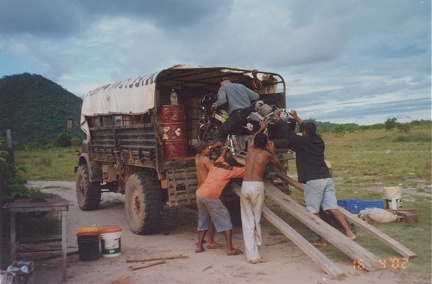 By late afternoon they gave up on repairing the brakes and we loaded the
bike by me riding it up a plank and into the back of the truck. Again we slept
on the dirt, exhausted, waiting to leave supposedly at 6 pm, then 9 pm, and
finally away at 11 pm. The Indian (Asian) owner of the shop and his native
wife in Basin village were incredibly hospitable giving us a meal and a small
package of food to take on the trip along with great friendliness. Quite
the opposite from the rip off and bad advice we received at Rock View Lodge
the two days earlier.
By late afternoon they gave up on repairing the brakes and we loaded the
bike by me riding it up a plank and into the back of the truck. Again we slept
on the dirt, exhausted, waiting to leave supposedly at 6 pm, then 9 pm, and
finally away at 11 pm. The Indian (Asian) owner of the shop and his native
wife in Basin village were incredibly hospitable giving us a meal and a small
package of food to take on the trip along with great friendliness. Quite
the opposite from the rip off and bad advice we received at Rock View Lodge
the two days earlier.
16/4/02 It was another 12 hours before we could unload
the bike having travelled just 140 km's. Kay could sit crouched over on the
motorcycle seat and I was sitting on a small generator. The truck usually
carried petrol in 1000 litre containers from Georgetown and was returning
with empty containers. There was the cook from a road camp returning from
visiting friends, a boy heading back to school and a carpenter returning home,
sitting or lying across drums or empty crates of beer bottles. These trucks
usually have a crew of three. The driver who is revered as an airline pilot
would be. Well dressed, in control and a master of his skills of getting
through the bad road. A mechanic, as always dirty and covered in grease and
a dog's body apprentice who does all the unsavoury jobs like being the dip
stick. Someone has to walk the deep water crossings to find the best path.
We were lucky having two drivers to alternate with sleep. The road was new
10 yrs ago but they had run out of money to complete the job and there has
been little maintenance, many trucks and lots of rain since then. The 4x4
Bedford trucks with raised central drive and wide knobbly tyres seems to
be the only ones capable of making the trip in the wet. It has incredibly
rigid suspension and creaks and groans as the chassis twists in and out of
deep ruts, feeling every bump in the road. The trail is one truck wide and
the wet rain forest branches hang down as a canopy.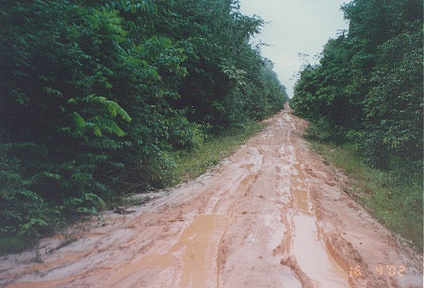 We slid and slipped all the way to the ferry crossing stopping to winch out
a bogged truck where the road was unpassable and another trail had been cut
through the forest. It was another three hours after the Kurupukari river
crossing before the patches of deep mud disappeared. We unloaded the bike
onto an earth mound and rode the 70 km to Mabura Hill on improving roads
and the further 120 km to Linden where we reached asphalt. Unfortunately the
reason for the improved dirt roads was to allow logging trucks into the area.
After a quick clean up of mud from ourselves and our gear we slept for 12
hours.
We slid and slipped all the way to the ferry crossing stopping to winch out
a bogged truck where the road was unpassable and another trail had been cut
through the forest. It was another three hours after the Kurupukari river
crossing before the patches of deep mud disappeared. We unloaded the bike
onto an earth mound and rode the 70 km to Mabura Hill on improving roads
and the further 120 km to Linden where we reached asphalt. Unfortunately the
reason for the improved dirt roads was to allow logging trucks into the area.
After a quick clean up of mud from ourselves and our gear we slept for 12
hours.
17/4/02 We washed most of the mud off the bike to find
some cosmetic damage had occurred in the truck. A bird cage had rubbed and
scratched the chrome, the bike had bounced down on to a wooden block too
many times and bent the muffler support and the top box had worn away the
fibreglass on one corner from rubbing. We were pleased to have ridden all
but 90 km of the trip and could never have made it with the road wet or probably
even if it ever dries out. We arrived in Georgetown still exhausted, muscles
sore from holding on in the back of the truck. Organized our Suriname visas,
transit for 3 days, $US 10.00, ($US 30.00 ordinary visas) and rested most
of the day.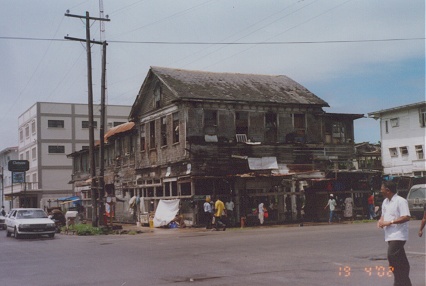
18/4/02 Georgetown, a predominantly black African descent
population with Indian sub continent people and some Chinese. We were about
the only Caucasians we saw. Like a percentage of the black Americans most
can speak good english but prefer their own Creole dialect version with its
slang. It's great to listen to but requires enormous concentration. Large
old wooden buildings, rundown due to lack of repair stand next to magnificently
maintained wooden structures. As Georgetown is built on reclaimed swampy
land our 3 storey wooden hotel vibrates and shakes as trucks pass in the
street. Horse drawn wagons still move produce in and around the wharf area
and mini buses race through the streets carrying people. Dropped here, you
could be in any of a dozen African countries. The town has a vibrancy and
an appeal hidden between wealth and destitution.
19/4/02 Headed east with the population becoming less African
and more Indian descent. Past many Hindu shrines and almost every Christian
denomination church and a couple of Mosques. The land along the coast all
lower than the sea water, kept back by a series of canals, gates and a sea
wall. Sugarcane and then rice the main agriculture in this swampy land. We
crossed the Berbice River on a large ferry that runs frequently only to be
stopped at the Suriname border at the Corentyne River. Here the ferry only
runs once daily, 11 am Guyanan time, so we wait in the pleasant border town
of Springlands.
20/4/02 The vehicle ferry has only been here for two years.
Prior to that there was no vehicle traffic between the two countries and even
now we only had six cars and no trucks on our once a day ferry. Formalities
start at about 9 am, $US 8.00 for passengers and $US 10.00 for the motorcycle.
Even though customs on entering Guyana didn't require a carnet here they insisted
on entering us arriving and then leaving using the carnet. A pretty relaxed
event with the ferry leaving late, no hurry only one trip a day.
Move with us to Suriname
 10/4/02 Brazil's paperwork also easy. Yellow fever vaccination
proof essential, we have obtained our Brazilian visas in Costa Rica, and
they were happy to use the Carnet and some of their own paperwork for the
motorcycle, no costs involved. Road good and ranching scenery with drying
dams and water birds kept us entertained on the almost traffic free road.
Boa Vista for the night. A planned sprawling town of little appeal.
10/4/02 Brazil's paperwork also easy. Yellow fever vaccination
proof essential, we have obtained our Brazilian visas in Costa Rica, and
they were happy to use the Carnet and some of their own paperwork for the
motorcycle, no costs involved. Road good and ranching scenery with drying
dams and water birds kept us entertained on the almost traffic free road.
Boa Vista for the night. A planned sprawling town of little appeal.


 By late afternoon they gave up on repairing the brakes and we loaded the
bike by me riding it up a plank and into the back of the truck. Again we slept
on the dirt, exhausted, waiting to leave supposedly at 6 pm, then 9 pm, and
finally away at 11 pm. The Indian (Asian) owner of the shop and his native
wife in Basin village were incredibly hospitable giving us a meal and a small
package of food to take on the trip along with great friendliness. Quite
the opposite from the rip off and bad advice we received at Rock View Lodge
the two days earlier.
By late afternoon they gave up on repairing the brakes and we loaded the
bike by me riding it up a plank and into the back of the truck. Again we slept
on the dirt, exhausted, waiting to leave supposedly at 6 pm, then 9 pm, and
finally away at 11 pm. The Indian (Asian) owner of the shop and his native
wife in Basin village were incredibly hospitable giving us a meal and a small
package of food to take on the trip along with great friendliness. Quite
the opposite from the rip off and bad advice we received at Rock View Lodge
the two days earlier.  We slid and slipped all the way to the ferry crossing stopping to winch out
a bogged truck where the road was unpassable and another trail had been cut
through the forest. It was another three hours after the Kurupukari river
crossing before the patches of deep mud disappeared. We unloaded the bike
onto an earth mound and rode the 70 km to Mabura Hill on improving roads
and the further 120 km to Linden where we reached asphalt. Unfortunately the
reason for the improved dirt roads was to allow logging trucks into the area.
After a quick clean up of mud from ourselves and our gear we slept for 12
hours.
We slid and slipped all the way to the ferry crossing stopping to winch out
a bogged truck where the road was unpassable and another trail had been cut
through the forest. It was another three hours after the Kurupukari river
crossing before the patches of deep mud disappeared. We unloaded the bike
onto an earth mound and rode the 70 km to Mabura Hill on improving roads
and the further 120 km to Linden where we reached asphalt. Unfortunately the
reason for the improved dirt roads was to allow logging trucks into the area.
After a quick clean up of mud from ourselves and our gear we slept for 12
hours. 